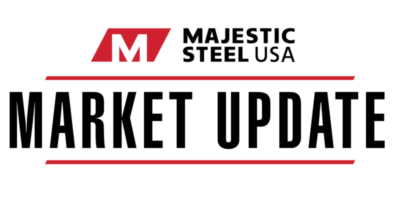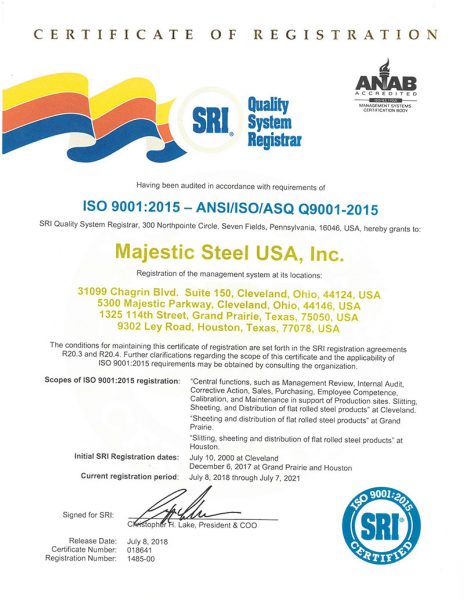Market Update | September 28, 2022
SUPPLY DECREASES AS ANOTHER FURNACE IDLES INDEFINITELY
After announcing the idling of the #8 furnace at Gary a couple weeks ago, USS confirmed that the #3 furnace at Mon Valley will be idled indefinitely as well. The #3 furnace, which has a daily capacity of 3,100 tons (~1.1 million tons annually), will now be down until “market conditions improve”. The two recent outages now equate to roughly 2.2 million tons annually.
Input Costs
The recent up and down movement for zinc subsided this week, as pricing dipped slightly from last week.
-
-
Zinc pricing came in at $1.42/lb this week, remaining below $1.50/lb for the third straight week.
-
Spot iron ore pricing rebounded slightly this week, climbing after sliding the previous two weeks but remained below $100/mt for the second consecutive month.
-
-
Spot iron ore pricing is currently at $97.60/mt, up 1.0% from the end of last week and is down 4.1% on a m/m basis.
-
Pacific Basin met coal pricing rebounded slightly this week, climbing to $266.50/mt.
-
-
Current pricing is up 3.9% from the end of last week and down 2.6% from this time last month.
-
While still a week-plus out from the October scrap buy week, early expectations are for both shredded and prime prices to decline $10-$20/gt compared to September.
-
-
Weak demand and ample supplies continue to negatively impact scrap pricing.
- If accurate, it would mark the 6th consecutive m/m decline.
-
Supply
Domestic raw steel production dropped dropped again last week, sliding to its lowest level since the first week of January 2021.
-
- U.S. steelmakers produced 1.683 million tons at an 76.4% utilization rate.
- YTD production is now down 4.0% from the same time last year.
After announcing the idling of the #8 furnace at Gary a couple weeks ago, USS confirmed that the #3 furnace at Mon Valley will be idled indefinitely as well.
-
- The #3 furnace had been going through a month-long out and will now be down until “market conditions improve”.
- The #3 furnace has a daily capacity of 3,100 tons (~1.1 million tons annually).
- The two recent outages now equate to roughly 2.2 million tons annually.
Nucor said Wednesday it will move forward with the $425M construction of a galvanizing line at Berkeley in South Carolina to support the company’s strategy of expanding its capabilities in the automotive and consumer durables markets.
-
- Nucor’s board also approved a galvanizing line to be constructed in the western U.S., with details to be announced later.
- The new South Carolina galvanizing line will have a capacity of 500K tons/year and will be able to produce galvanized steel up to 72 inches wide.
Based on preliminary import licenses, the daily average for September (25 days) is down 8.1% from the daily rate in August.
-
- Coated sheet imports are down 12% compared to the same time frame in August and are pace to have their lowest monthly total in nearly two years.
- Excluding volatile slab imports, the daily average is down 10.5% from August.
Total carbon steel imports declined sharply in August, sliding to 1.882 million tons.
-
- This is down 12.5% from July and is at its lowest level since February.
- August’s total was down 15.6% from August of last year as well.
- Carbon flat rolled imports total 633,858 tons, up 5.6% from July but down a significant 27.9% from 879,392 tons in August 2021.
- While hot rolled imports dropped sharply in August, increases in both cold rolled and coated flat rolled imports pushed to total higher.
- Cold rolled and coated imports increased 16.8% and 15.5%, respectively.
DEMAND
New orders for manufactured durable goods slipped slightly in August, now down for the second consecutive month.
-
-
New orders came in at a $272.7 billion rate, down 0.2% from July.
-
Excluding the volatile transportation segment, new orders were up 0.2%.
- New orders for primary metals increased to a $20.8 billion rate; climbing 0.4% from July.
- Fabricated metal product new orders slipped however, sliding 0.7% to a $36.9 billion rate.
- Unfilled orders for manufactured goods, increased 0.5% to a $1.132 trillion rate.
- Unfilled orders, a sign of future demand, are now up for the twenty-fourth consecutive month.
- Inventories of durable goods increased as well, climbing for the nineteenth consecutive month.
-
After sliding the previous two months, new home sales increased sharply in August.
-
-
August new home sales came in at a 685,000-unit rate, up 28.8% from July.
-
Sales were down slightly (0.1%) on a year-over-year basis however, marking the fifteenth consecutive month with a year-over-year decline.
- Year-to-date actual new home sales are still down 14.3% however, compared to the same timeframe last year.
- Despite seeing the sharp increase in new sales, new homes for sale at the end of August increased for the sixth consecutive month.
- Inventory increased to 467,000 units, the highest level since February 2008.
- The current inventory, combined with the August sales rate, equated to 8.5 months.
-
ECONOMIC
U.S. consumer confidence increased again in September, climbing to its highest level in five-months.
-
-
The Conference Board’s Consumer Confidence Index came in at 108.0.
-
The current view component increased to 149.6 in September from 145.3 previously.
- The component that measures confidence six months out increased as well, climbing to 80.3.
- This is the highest level for this component since March.
- Falling gas prices, a continued strong labor market, and rising wages all played a part in pushing confidence higher in September.
-
This material, information and analyses (the “Content”) may include certain statements, estimates and projections prepared with respect to, among other things, historical data and anticipated performance. Content may reflect various assumptions by Majestic Steel USA, Inc. concerning anticipated results that are inherently subject to significant economic, competitive and other uncertainties and contingencies and have been included for illustrative purposes. Content is provided AS-IS.

